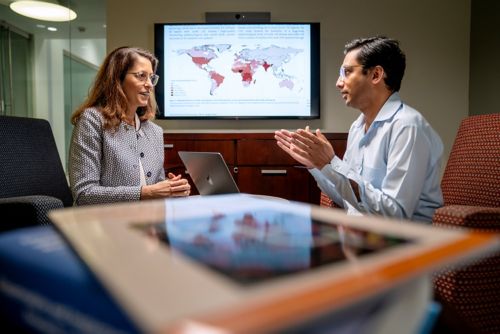Collaborating for Care: Developing a New Global Standard for Sickle Cell Disease Treatment

Jane Hankins, MD, and Akshay Sharma, MBBS, discuss the future of sickle cell disease treatment.
Picture a world where borders are not a barrier to quality health care, where individuals diagnosed with sickle cell disease receive consistent, evidence-based care regardless of their geographic location. While this isn’t the state of our world today, through collaboration and the dedicated work of individuals around the globe, it could be.
Cases for many of the leading causes of mortality are decreasing; unfortunately, the same cannot be said for sickle cell disease. Sickle cell disease is among the top 50 most common causes of non-communicable deaths globally. Despite its prevalence and the availability of simple and effective interventions, sickle cell disease has been largely neglected by governmental health ministries and global health communities, with outcomes and survival rates varying drastically depending on geography and socioeconomic status.
The burden sickle cell disease places on patients and communities, coupled with the widening inequalities facing low- and middle-income countries regarding resource access, highlights the necessity of establishing a new standard of care.
Leading experts in sickle cell disease at St. Jude Children’s Research Hospital understand that easing the global burden of sickle cell disease cannot be achieved alone, so when the opportunity to contribute to the new standard of care called, they readily answered. The Lancet Haematology Commission, a diverse group of patients, activists and sickle cell disease experts, including those from St. Jude, was assembled to address the challenges facing this neglected genetic disease, especially in low- and middle-income countries. They devised a set of recommendations to achieve greater political commitment, investment and partnerships to improve patient care for sickle cell disease globally over the next few decades.
Navigating an unequal burden and shifting the status quo
Sickle cell disease is a hereditary hematological condition affecting red blood cells’ shape and ability to pass through smaller blood vessels. The sickle-shaped red blood cells from which the disease gains its name lack plasticity and block smaller blood vessels in different organs. This can cause low blood oxygen levels and organ injury, leading to chronic acute pain syndromes, severe infections and necrosis (tissue death). An estimated 500,000 babies are born with the disease every year, although the majority in low- and middle-income countries remain undiagnosed until they experience symptoms. Many others die without a proper diagnosis — mortality ranges between 50 and 90% before age five on the African continent alone.
In high-income countries, where access to interventions such as regular blood transfusions, vaccinations and pharmaceutical therapies is greater, outcomes for patients with sickle cell disease have improved. However, in Brazil, India and Sub-Saharan countries in Africa, where the global burden of sickle cell disease is greatest, outcomes are less than optimal. These disparities could be attributed to a host of reasons, including economic constraints on health infrastructure, a lack of standardized training for sickle cell care and racial biases.
“Even though sickle cell disease is one of the most common genetic diseases — the first to have its molecular basis described — there has not been a lot of effort addressing this disease over the last 50 years,” said Akshay Sharma, MBBS, St. Jude Department of Bone Marrow Transplantation and Cellular Therapy. Sharma was one of the contributors to the Commission. “Because the majority of the people affected by sickle cell disease are living in Africa, South America and India, it has been an underappreciated disease.”
Mitigating global disparities in access to curative care for patients with sickle cell might appear to be an ambitious endeavor, but it encapsulates the core mission of the Commission. Recent advancements in gene therapy for treating sickle cell hold promise in this pursuit. However, realizing universally accessible curative care requires several gaps to be bridged. To accomplish this, leading experts in the Commission underscored the importance of laying solid foundations so that all patients can receive a baseline standard of care.
Such groundwork has already begun at St. Jude within the Global Hematology program. “Through St. Jude Global, we have expanded our scope beyond cancer to answer this urgent call in the realm of non-malignant catastrophic diseases of childhood,” said Jane Hankins, MD, St. Jude Global Hematology director. “Through St. Jude Global Hematology, my team and I will focus on these non-malignant blood disorders, starting with sickle cell disease, since the disease has the highest burden among children worldwide.”
But what does that baseline care look like? Before the Commission could begin listing their recommendations, they first needed to establish which care facets were the highest priority.
A convergence of expertise
Contributors divided themselves into five distinct subgroups based on their specific areas of expertise: sickle cell disease epidemiology, screening processes, established care for sickle cell disease management, emerging cellular therapies and training and education. Within these groups, the experts highlighted what steps stakeholders needed to take to bolster treatment in underserved populations and how to do so in a culturally sensitive manner.
While mapping the lay of the land regarding cellular therapy, Sharma and his collaborators realized crucial medical infrastructure needed to be implemented before access to cellular therapies could be readily available. For example, some patients — particularly those from African countries — must travel internationally to obtain cellular therapies, such as bone marrow transplantation. To mitigate these burdens and eventually ensure ready access to such treatments, Sharma and his colleagues identified a need for blood banks, safe blood transfusions, radiation X-rays and access to critical drugs, such as hydroxyurea.
“Those were some of the building blocks,” Sharma explained, “and we said, ‘OK. These things are not that difficult to establish. Can that be achieved over the next five to 10 years?’ We believe that if you follow these steps, gene therapy will be possible in the next 10 years; it may not be possible right away because of technological constraints, but if you have gone through these steps, then gene therapy can be done.”
From this assessment, a pathway to globally accessible cellular therapies unfolded.
The other groups within the Commission underwent a similar process of deconstructing their designated problem to discern viable solutions supporting their larger goal. Once each group felt confident in their assessment, it was time to converge and share their plans with the other members of the Commission. What followed was a spirited debate among passionate stakeholders, trying to determine which recommendations were optimistic, which were feasible and which needed to be reprioritized.
After several iterations of debate and receiving outside input from philanthropic leaders, pharmaceutical representatives and health ministries, the Commission arrived at 12 key recommendations for standardizing sickle cell disease care. The recommendations serve as a blueprint, with the aim to tackle the disease from multiple fronts and halve the global burden by 2050.
“Once we debated as a larger group, we were able to weed out some of the more ambitious recommendations, which we thought were important but needed to wait. We didn’t want to overwhelm outside stakeholders; we wanted to trim down to a few recommendations, which we thought were absolutely necessary, and then be able to return to those recommendations later,” said Sharma.
Leaping the hurdles: Challenges facing recommendation implementation
Perhaps the biggest challenge the contributors dealt with was creating a comprehensive document while still being aware of cultural differences and needs — one that would not pigeonhole them into focusing on one specific region at the expense of the others. As each country’s cultural identity is diverse and nuanced, so must the approach be for sickle cell care.
Once the recommendations are in the hands of vested authority figures, the challenge then becomes how to adapt. The implementation steps needed in the United States will inevitably differ from those in Tanzania, which will, in turn, differ from those in India, which will differ from every other impacted nation. These recommendations are not a one-size-fits-all solution.
“I believe the challenge will be for these countries to adapt these guidelines to their local setting,” stated Sharma. “It will require fine-tuning for health departments or ministries of health in different countries to pick up this document and adapt them to their current systems.”
The intersection of compassion and expertise
Many factors can spark a scientist’s interest in a given subject, from an intellectual challenge to an emotional connection. Sharma’s interest in sickle cell and its treatment was first spurred by his experience treating its cousin, beta-thalassemia, in India.
Beta-thalassemia and sickle cell disease are conditions associated with hemoglobin development. However, where sickle cell disease is a qualitative problem, beta-thalassemia is a quantitative problem. Both diseases affect the beta-globin gene, but sickle cell is associated with defective hemoglobin, whereas beta-thalassemia is the absence of it.
“I grew up seeing patients with thalassemia, and then I came to the US to further my training. When I saw my first patient with thalassemia here, I was surprised because, in India, the disease manifestations look different,” Sharma explained. “This [American] patient appeared absolutely normal compared to what I was used to seeing in India, and the only treatment they were receiving was regular blood transfusions. When I saw that, I realized it was the same disease with patients being treated in two different countries, but because of the role of access and available treatments, one patient appeared completely normal while the other distinctly presented their symptoms.”
The moment was an eye-opening revelation, highlighting a truth that he always understood intellectually but had not observed first-hand: regular access to treatments matters.
When Sharma arrived at St. Jude, he put that knowledge and conviction to work, joining forces with Mitchell Weiss, MD, PhD, St. Jude Department of Hematology chair, to study the genetic mechanisms governing globin regulation. This research helped expand the understanding of how beta-thalassemia and sickle cell disease develop. It also helped Sharma and his colleagues develop new cellular and gene therapies to treat hemoglobin disorders and further improve their outcomes.
“Combining my background of seeing patients with hemoglobin disorders in India and the US with my training in developing cellular therapies made sense; it opened a one-track pathway that would allow me to scratch all the ‘itches’ I had,” Sharma said.
However, developing the therapies is only the first step in a larger goal for Sharma. He has not forgotten his first stark example of how access to treatment can impact patient outcomes. Sharma and his colleagues, including Hankins, have made it their mission to bring their work at St. Jude to the global stage.
“Our work in St. Jude Global Hematology is all geared towards understanding the local context and adapting treatments that are given in high-income countries to low- and middle-income countries by using implementation strategies,” Hankins said.
Forging new paths
Treating and developing new therapies for hematological disorders, including sickle cell disease, has always been integral to the work done at St. Jude. The first patient ever cured of sickle cell was treated by St. Jude clinicians using bone marrow transplantation. The hospital’s research since — such as lentiviral vector and hydroxyurea studies — has greatly improved outcomes for domestic patients.
Looking towards the future, St. Jude researchers are creating and optimizing gene therapies to treat and potentially cure sickle cell disease at the genetic level. Sharma has already led a clinical trial for a gene therapy to treat sickle cell. He will continue to lead new clinical trials to improve lives and hopefully fully cure these patients one day.
As global health ministries attempt to adapt the new sickle cell care guidelines, St. Jude is poised to lead the way in developing viable solutions. For example, through St. Jude Global Hematology, Hankins is working on developing guidelines in collaboration with the World Health Organization.
“We have already done so much work here institutionally. Now we can share all that work where the impact will be a hundred times greater than what we have achieved so far,” Sharma enthused. “We have the capacity; we have the know-how; we have the technical knowledge of how to do these things. We can be the cheerleaders, the ones spearheading this change all around the world in collaboration with others. We have the opportunity and the responsibility to do so.”
When reflecting on the Commission’s work and the road ahead, Sharma shared his sense of optimism. “I think the conversation is starting, and if we can keep that momentum going and build upon that, hopefully, one day, we will reach a point where we can look back and say, ‘You know what we said back in 2023? We achieved that.’”
St. Jude investigators who contributed to the Lancet Commission commentary include Hankins, Jerlym Porter, PhD, and Andrew Heitzer, PhD, both of St. Jude Department of Psychology and Behavioral Sciences.






